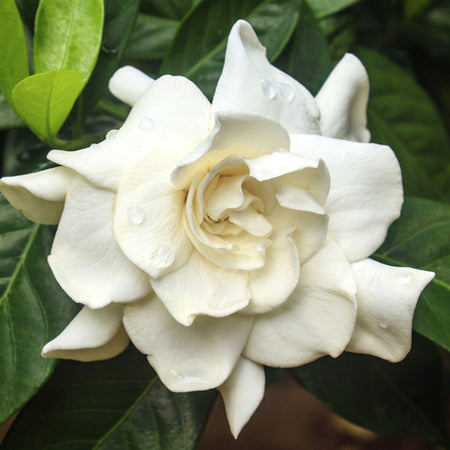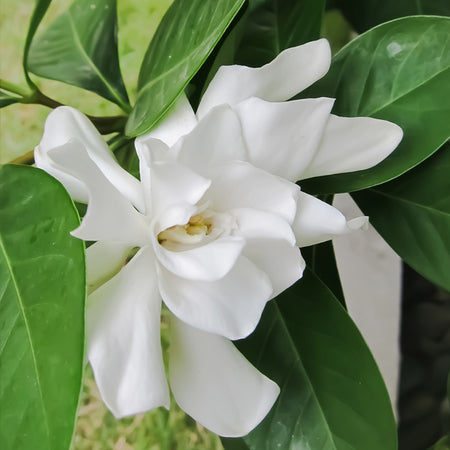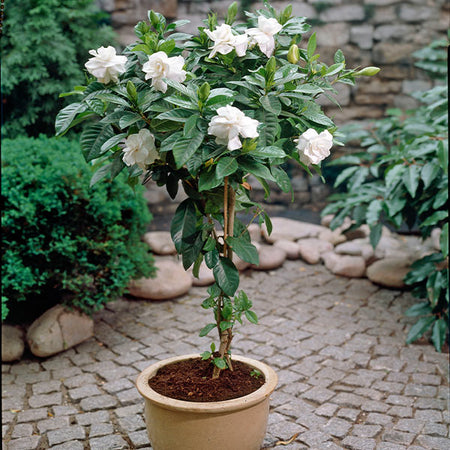Gardenia Plants
Showing 1 - 7 of 7 items
Starting at $22.99
Growing Zones: 8-11
Starting at $28.99
Growing Zones: 7-10
Starting at $45.99
Growing Zones: 7-10
Starting at $57.99
Growing Zones: 7-10
Starting at $36.99
Growing Zones: 7-11
Sold Out
Growing Zones: 8-11
Sold Out
Growing Zones: 8-11
The Complete Guide to Gardenias
The gardenia's fragrance on a warm summer's night is breathtaking. When a gardenia is planted near a deck or patio, it's inviting smell will eventually be a conversation piece when hosting friends or family. When they are not in full bloom, gardenias are wonderful evergreens.
Year in and year out, this shrub will become your "best friend" and a great source of pride.
There is a myth that since gardenias give you such amazing fragrance, they're high maintenance. Contrary to popular opinion, the gardenia is not hard to grow or to maintain, nor must you live in the Deep South or the Tropics to enjoy its beauty. We have created this guide to assist you in growing and maintaining these magnificent plants.
The Top Gardenia Varieties
We stock a number of different varieties of gardenias in 1, 2 and 3 gallon sizes for planting and also for gift purposes. The gardenia is a shrub, but it can trained to be a small tree or other varieties can be kept as potted plants. Our selection includes:
Frost Proof Gardenia - So popular because it resists late frosts, which can damage blooms.
Kleim's Hardy Gardenia - Miniature variety can be grown and maintained indoors as a potted plant. It can literally fill your home with a citrusy scent.
Dwarf Radicans Gardenia - The perfect border plant, getting about two feet tall. Low maintenance and drought resistant.
August Beauty Gardenia - Huge, 3" blooms that last up to 3 months. Several plants can be made into a hedge.
August Beauty Gardenia Tree -This is a long-blooming gardenia pruned into a tree. It can be potted on your patio, then brought indoors when the weather turns cool.
Blooming Gardenia Gift - Imagine giving the gift of a gardenia plant in full bloom! We ship the day after your order. It is the gift that never fails to delight and impress.
Background Info on Gardenias
Gardenias crave warmth and they need moisture. Some varieties will survive a light frost, but they will be unhappy surviving in climates cooler than Zone 7. Yes, they can be drought tolerant once well established, but do not neglect them for an entire season.
Tropical soils are typically soils that are more on the acidic side. The ideal range is soil with a pH between 5.0 and 6.0, bou do not need a degree in chemistry to keep the soil at this pH level. We recommend acidic fertilizers; then there is always our trusted garden companion peat moss. Some gardenias defy the odds and grow, without amendment, in any soil they find. They are a little more forgiving. The Dwarf Radicans Gardenia falls into that category.
When planting near concrete like patios or sidewalks, you might want to consider adding acidic fertilizers. Concrete is quite alkaline, and can leech chemicals into the soil. In other words, most of your garden soil could be quite suitable for gardenias, but the edges around the new concrete could be alkaline.
Gardenias like bright, but not harsh, direct sunlight. They are not shade lovers. If left on their own as a showcase shrub, they will take on a beautiful round shape with gorgeous, dark green and glossy leaves.
How to Plant Gardenias
Gardenias thrive outdoors in growing zones 7 to 10. You may be fortunate and have a warmer microclimate in a part of your garden that is in a lower numbered zone, but in most cases where you are below Zone 7 temperature range, your gardenia will do better if it is a potted shrub and can be brought indoors as the temperature cools. As a quick rule, if your garden ever gets below 10 degrees F, your gardenia should be in a pot.
Before you plant your gardenias, you will want an area in your garden that gets full sun for several hours a day; at least six hours a day. If you live in an area of intense sunlight, we recommend light shade. These sunlight requirements apply whether the gardenia is an outdoor plant, or is a potted plant that is brought indoors.
The area you select should have rich, acidic soil that is well-drained. Check your area's extension service or even ask a local garden club member for your soil conditions. If the soil does not have the pH range of 5.0 to 6.0, it should be brought to that level. Don't choose a spot where the ground gets soggy. If you live in an area where the soil is clay or very sandy, we highly recommend using a gardenia soil, or adding organic matter such as peat moss and aged compost. If you are planting your gardenia in a large ceramic pot, the same rules apply to the soil in the pot.
We recommend planting your gardenias about 3 feet to 6 feet apart, depending on the size of the variety you've chosen. Do not plant the gardenia deeper than its root ball, but be sure to dig the hole as least 3 times as wide. Even outdoors, gardenias can become root-bound. After you have carefully removed the plant from its container (if an outdoor plant), fill the hole to about the one-half point add some water and let it drain then fill it in the rest of the soil. Water it thoroughly!
It is also recommended that you add a thick layer of peat moss topped by a layer of mulch around the plant. Gardenias love this. We recommend you add gardenia plant food about once a month to the soil around your outdoor or indoor plant. This is important as the plant comes back to life in the spring and starts to flower.
Here's a tip about watering: water at root level. Watering the flowers will cause them to turn brown.
Gardenias can easily be pruned. We recommend you do this in early spring to shape the bush. As the gardenia flowers and the flowers wither, remove the flowers to stimulate even more beautiful blooms.
Gardenias can sometimes develop mealybugs or flies. There are very safe insecticidal soaps for that purpose. However, our experience has shown that problems usually occur in those regions where the plant is stressed, unprotected from hot winds, under-watered or in poor, unfertilized soil. Many problems can be avoided by proper care.
Once established, they are pretty much worry-free and are no more difficult to care for than roses or any other flowering shrub. Are they worth the slightly extra effort? Well, let's put it this way: the first evenings when you sit quietly near your blooming gardenia, you will forget about any effort it took to get it established. It is truly that magnificent.
Fun Gardenia Facts
Your gardenia will be the envy of the neighborhood. Friends and neighbors will be dropping by to enjoy the fragrance! Here are a few fun facts about your gardenia that will really impress them:
• In Asia, the flowers of the gardenia have been used to dye fabrics a beautiful yellow. The color has also been used as a natural food color.
• The fragrance terms "jasmine" and "gardenia" have been interchangeably used! However, they are different plants. The reason for the confusion is that the scientific name for the plant is Gardenia jasminoides.
• Gardenias were once essential flowers for a New York City dandy to wear in his button-hole when going out on the town in his tuxedo.










